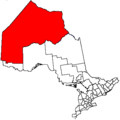Wabaseemoong | |
|---|---|
| Wabaseemoong Indian Reserve | |
| Coordinates: 50°10′N94°56′W / 50.167°N 94.933°W | |
| Country | |
| Province | |
| District | Kenora |
| First Nation | Wabaseemoong |
| Area | |
| • Land | 75.55 km2 (29.17 sq mi) |
| Population (2011) [1] | |
• Total | 832 |
| • Density | 11.0/km2 (28/sq mi) |
Wabaseemoong is a First Nation reserve of the Wabaseemoong Independent Nations. It is in Kenora District, Ontario, Canada, close to the border with Manitoba. It used to be known as Islington 29.

